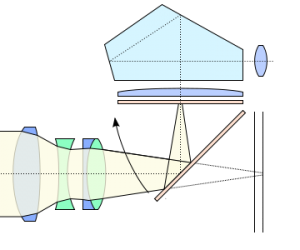
The piece that revolutionized photography and made the SLR possible is the same piece mirrorless systems are looking to eliminate. That of course is the pentaprism. If you are scratching your head wondering what the heck it is, the pentaprism is located just above that mirror that flips up when you take a photo and directly in front of the eyepiece. The function it serves is to direct the image into the viewfinder from the lens so you are able to see through the lens. Before we had the ability to look through the lens there were viewfinders. Aside from the problems of parallax, cameras with the ability to interchange lenses photographers also had a viewfinder for each lens so that they could get a close representation of what the lens gave them.
DIAGRAM 1:
DIAGRAM 2:
There are two kinds of pentaprisms. The first is the classic (see diagram 1) and by today’s standards is pretty big. It is generally one single solid piece of glass with two mirrored surfaces. The second is what is called a roof pentaprism (see diagram 2) aptly named because of the triangular roof shape it has. It is made up of a solid piece of plastic with three mirrors glued to the surfaces. The advantage of the roof pentaprism is that it is more compact, lighter and is cheaper to produce; the disadvantage, in terms of viewing, is diminished image quality and that it is less bright.
Believe it or not even the pentaprism can fail on cameras. Most commonly there is just dust build up. There are two places it can build up. The first is the surface facing your mirror. This is the most common and easiest to remove; generally it just takes a bit of air. The second is the surface facing the viewfinder. Any debris inside the eyepiece area is much more difficult to remove and requires disassembly. Luckily anything that goes wrong with this part of the camera doesn’t affect your images other than maybe your ability to see. If any kind of debris or dried liquid is settled on those surfaces the only thing you can do is replace it because no matter how careful you are it will scratch. The other least common issue we see is fogging or discoloration. Generally this happens in extreme heat. Don’t worry it may just humidity and will clear up after a while. However, if it does turn out to be the pentaprism then it will need to be replaced.
{ 2 comments… read them below or add one }
I am curious what they used to make the mirror on the pentaprism, is it mercury?
Can’t say for sure what each manufacturer is using. However, it is doubtful they are using mercury. Check out this article on Wikipedia called Silvering which should be a good place to start.